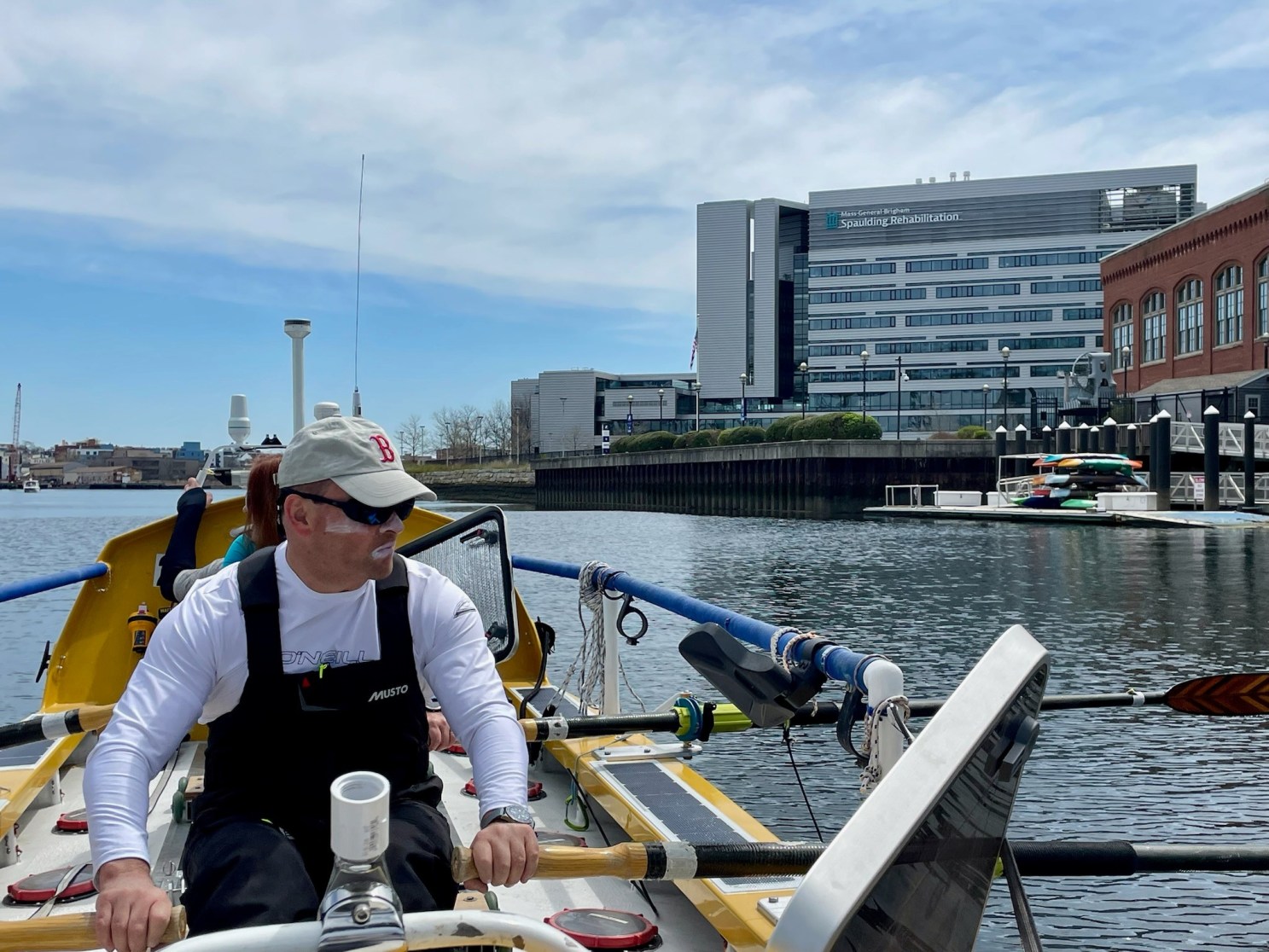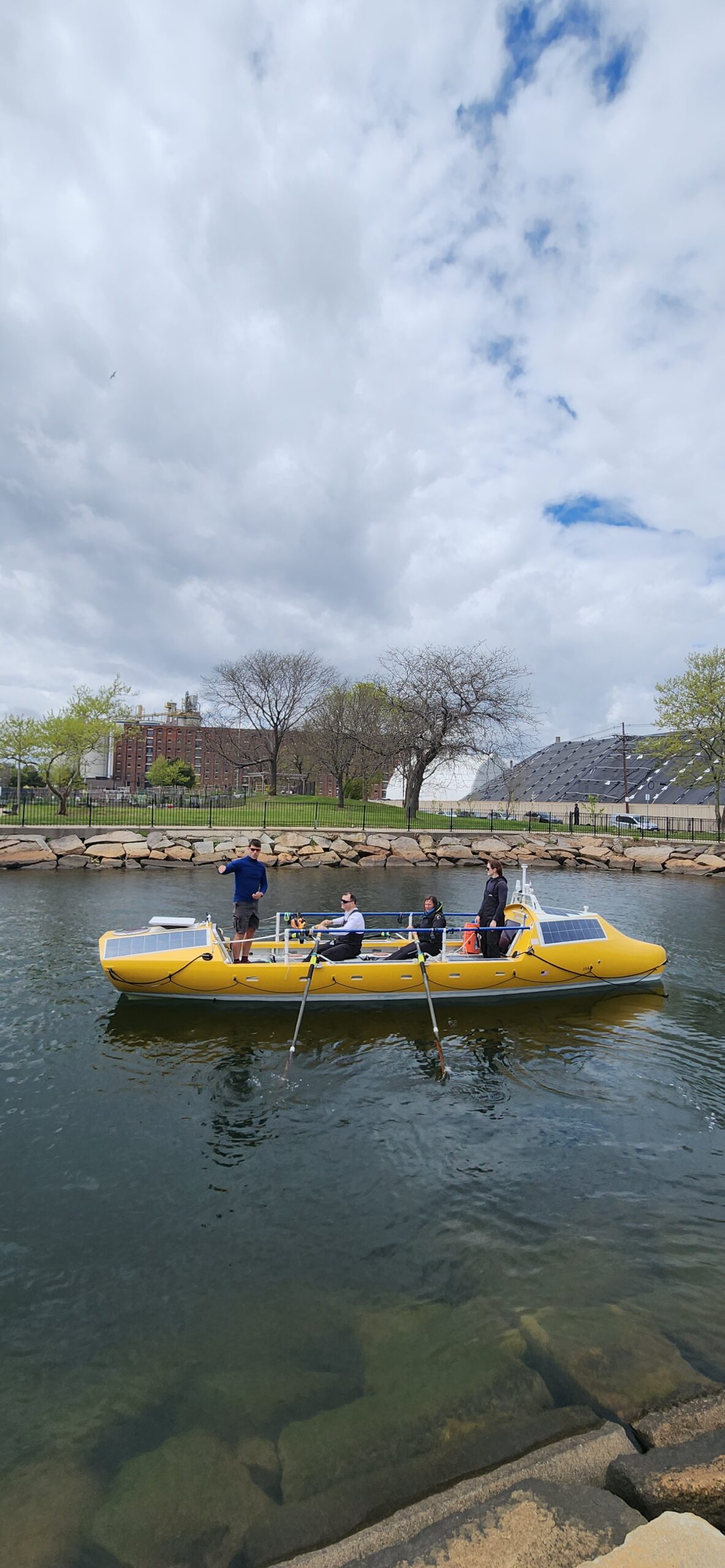
John Lowry.
Photo Courtesy of John Lowry
Why row from Boston to London? Because it’s there.
Spaulding Rehabilitation physician, team taking new route, aim to set records
John Lowry, a physician at Harvard-affiliated Spaulding Rehabilitation at Mass General Brigham, recently set off on an attempt to row across the North Atlantic on a route that begins in Boston and has never been tried before. He and his crew are doing so to raise funds for various charities, and hopefully to break some records. Lowry, who is also an instructor at Harvard Medical School, spoke with the Gazette about the upcoming quest and shared why it’s always a good idea to push yourself to do hard things. This interview has been edited for length and clarity.
Has anyone rowed across the Atlantic Ocean before?
The whole endeavor of ocean rowing got its start back in the 1960s. Two individuals crossed the North Atlantic in opposite directions and became the first people to cross the Atlantic solo. They both finished relatively close to the Apollo 11 moon landing, so it kind of got lost in the news.
But since then there have been subsequent trips taken across, although it was still viewed as a fringe sport, not really sponsored by anybody, just people who were interested in adventure. Everything was sort of DIY.
In the last 20 years, it has become more of an established — probably still fringe — sport. But the technology has improved tremendously. The boats are purpose-built for ocean rowing. They’re more seaworthy, lighter, more durable, and also able to carry modern electronics aboard, including for communication and GPS. Navigation has made this more accessible to broader participation.
In the Atlantic, the primary route is off the coast of Africa to the Canary Islands to Barbados to the Caribbean. It’s part of a larger race series that takes place, usually December into January. And every year a couple of hundred people go. It’s a well-supported, sponsored, sanctioned event. The South Atlantic is warmer, and it’s a bit calmer than the North Atlantic.
Tell us about what makes your trip unique.
What we’re doing is unsanctioned. We’re going as an independent team, not under the auspices of a larger race or organization. There are four of us. I’ve known Capt. Bryan Fuller since we were about 5 years old. And he did the Talisker Whiskey Atlantic Challenge in the South Atlantic about 12 years ago. Before the pandemic, he hatched the idea of doing the North Atlantic journey — going west to east — but the pandemic locked things down. There were shifts in the original crew, and I joined the effort about a year ago. We’re also joined by champion rower Elizabeth Gilmore and Klara Anstey, a rower from Wales.
If we’re successful, we’ll be the first human-powered crossing from Boston to the U.K. [Past North Atlantic crossings began in New York.] We will also be the first mixed crew (in terms of gender) ever to cross the North Atlantic. We’re hoping to break the North Atlantic record for speed.
How long do you expect it to take?

The London Calling Row Team pushed off for a 24-hour test run. The crew includes Captain Bryan Fuller, First Mate John Lowry, Elizabeth Gilmore, and Klara Papp Anstey.
Photo Courtesy of Jennifer Powell
We leave on June 1 and hope to reach the Isles of Scilly — which are the first U.K. territory we’ll encounter, just south of Cornwall — in or under 42 days. From there, we stop the clock. Then we proceed up the English Channel and up the Thames to downtown London. We expect that will take us another week or so. Technically, it will be the most difficult part of our row because the currents and tides in the English Channel will make it especially arduous.
Logistically, how do you manage rowing as a four-person crew for that long?
We’ll be on a seagoing schedule, meaning that there will be watch time — where we’re also rowing — and time off watch. The shifts will be anywhere from one to four hours, with the average shift length being two hours of rowing, two hours off. At night, in the interest of getting a bit more sleep, we’ll be on for four hours and off for four hours. But the boat will be rowed 24 hours a day.
How big is the boat?
The boat itself is 28 feet long and not quite 5½ feet wide. There are compartments in the bow and the stern. We’ll be hot bunking, so if one person is rowing the other can have the compartment. That being said, at 5’ 10”, I still have to pretty much be in the fetal position to be able to get in and sleep. There is room for two people in each compartment if conditions become rough or unsafe and we must take refuge.
What will you do for meals?
Each of us — for the length of the trip — is budgeted 180 freeze-dried meals, just like you would buy at REI. We’ll have a jet boil to boil water. You add it; wait 10 minutes; and then have a meal for which hunger increases your appreciation.
We’ll probably be consuming up to 4,000 calories a day, but we’ll be burning through close to twice that. We’ll all be losing quite a bit of weight as we go across, so right now we’re all trying to gain as much as we can. Probably the last time in my life I’ll have that luxury.
You recently went on a 24-hour test row. How did that go?
We rowed out of Boston on a Saturday, went north about as far as Marblehead, and turned around. But it was an opportunity for us to test the two-on-two-off schedule and to get a feeling for navigating, especially at night. It went well. I think we gelled as a crew, and it was important to learn how the boat handled.
But I think equally if not more important is to know how we work together as a team, to maintain safety and have a good flow. If somebody is walking down the deck from one end to the other, they can’t just do that because it would tip the boat over. There must be a really tight, cohesive coordination. I think that trip gave us a lot of confidence.
Why did you decide to participate in this endeavor?
Personally, I thrive when I’m challenged. Professionally, I take care of persons who have various disabilities. And one thing that society often does, intentionally or inadvertently, is deny people with disabilities the opportunity to dare to do new things, to take new risks in life.
For example, for a wheelchair user, that might mean buying an airplane ticket, figuring out how to travel by air, how to access a hotel transportation. It’s daunting, and for some people, it’s way more daunting than rowing across an ocean.
So I’m doing this to bring awareness to the idea that as physicians, it’s a good and healthy thing to help your patients stretch themselves a little bit and to problem-solve ways of pulling things off. And if things don’t work out, understand that “failure” is an opportunity to learn what did not go right and to rectify that.
What will the funds you raise support, beyond the trip itself?
I’m supporting the Spaulding Adaptive Sports Centers [a part of Spaulding Rehabilitation], whose mission is very closely tied to taking individuals who’ve had various injuries or impairments and putting them in an environment where they may be a little bit uncomfortable and enabling them to succeed. And not only to succeed but have fun doing it.
We want to engender the skills and the confidence that transfer into their larger life, to live fuller, more complete lives. The funds will help support the Spaulding networks and the adaptive sports program to help people access equipment and programming.
There’s quite a bit of risk associated with this trip. Why is it worth it, to you and the team?
As they say, without risk there is no reward. I can’t wait to meet the person I am when I come back. I think I will have a deeper appreciation for just about everything. And the only way to achieve that is by assuming that risk.
I have college students who tell me they are thinking about medical school. And I tell them the last thing you should ever do is try to talk somebody into becoming a doctor. If you can’t talk them out of becoming a doctor, it’s probably the right choice. And for me, the decision to take this trip was very similar.
I think my other motive in doing this trip is for professionals, particularly healthcare providers and physicians, we get really caught up in the day-to-day routine of what we do. It can be all-consuming, almost to the exclusion of the rest of our lives. And who hasn’t gazed out the window and wondered about that big trip or that project that they wanted to do, but have almost immediately dismissed the idea because they thought it impractical.
I want to challenge that assumption. With careful planning, patience, and commitment, it actually is possible to pull off a big project. And it can be a positive force in one’s career trajectory.
If people want to follow your voyage, is there a way to do so?
Our website is londoncallingrow.com. Through the website, there will be a link to our dot tracker that will tell you down to about a meter of resolution where we are on the ocean. We also will have Starlink access onboard, so we’ll be able to upload posts and hopefully some photos and video to keep people apprised of our progress.
Get the best of the Gazette delivered to your inbox
By subscribing to this newsletter you’re agreeing to our privacy policy




